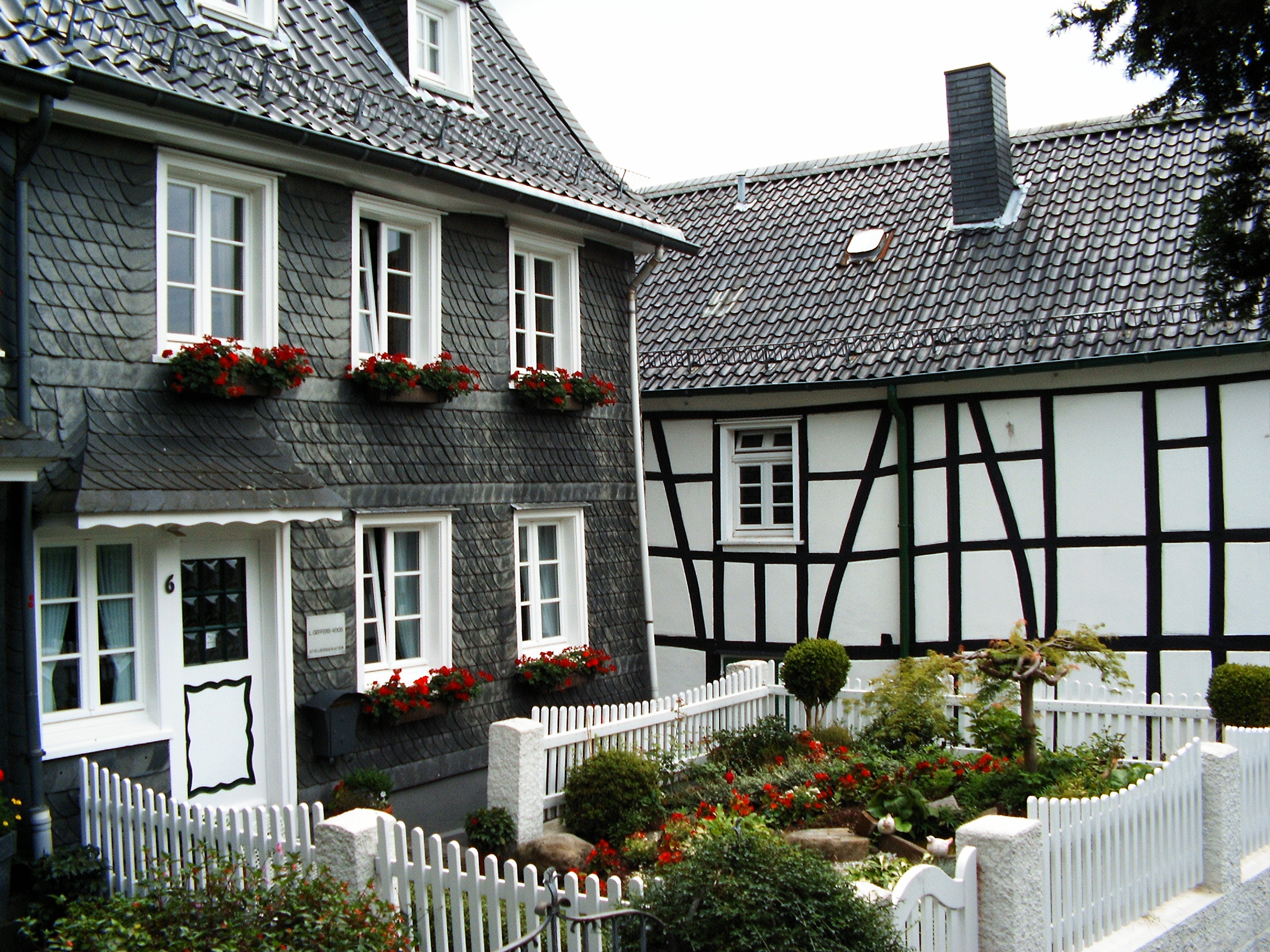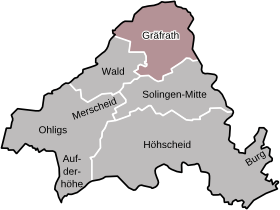|
Solingen
Solingen (; ) is a city in North Rhine-Westphalia, Germany, 25 km east of Düsseldorf along the northern edge of the Bergisches Land, south of the Ruhr. After Wuppertal, it is the second-largest city in the Bergisches Land, and a member of the regional authority of the Rhineland. Solingen is called the "City of Blades", and has long been renowned for the manufacturing of fine swords, knives, scissors and razors made by firms such as WKC, P.D Rasspe Söhne, DOVO, Wüsthof, Zwilling J. A. Henckels, Böker, Güde, Hubertus, Diefenthal, Puma, Clauberg/Klauberg, Eickhorn, Linder, Carl Schmidt Sohn, Dreiturm, Herder, Martor Safety Knives, Wolfertz, Ralf Aust and numerous other manufacturers. The medieval swordsmiths of Solingen designed the town's coat of arms. In the late 17th century, a group of swordsmiths from Solingen broke their guild oaths by taking their sword-making secrets with them to Shotley Bridge, County Durham, in England. Geography Solingen lies south ... [...More Info...] [...Related Items...] OR: [Wikipedia] [Google] [Baidu] |
Wüsthof
Wüsthof (, often styled in all capital letters; also known as Wüsthof Dreizackwerk ( German) and Wüsthof Trident ( English); sometimes spelled ''Wusthof'' or ''Wuesthof'') is a knife-maker based in Solingen, Germany. The company's main products are kitchen knives for domestic and professional use. Wüsthof is one of the largest manufacturers of chef's knives. Wüsthof knives are manufactured in Solingen east of Düsseldorf, Germany where around 400 of the company's 480 employees work. Wüsthof's trademark is a trident in a circle. The brand is sold in over 80 countries worldwide. In North America, traditionally the largest market for Wüsthof products, the company operates two local distribution subsidiaries. History Johann Abraham Wüsthof's Solingen ''"Shears factory, steel and iron works"'' is first mentioned in local records in 1814. The factory, one of many of its kind at the time, operated out of a so-called 'Kotten', a small grinding workshop with water-driven gri ... [...More Info...] [...Related Items...] OR: [Wikipedia] [Google] [Baidu] |
Bergisches Land
The Bergisches Land (, ) is a low mountain range in the state of North Rhine-Westphalia, Germany, east of the Rhine and south of the Ruhr. The landscape is shaped by forests, meadows, rivers and creeks and contains over twenty artificial lakes. Wuppertal is the biggest town, while the southern part has economic and socio-cultural ties to Cologne. Wuppertal and the neighbouring cities of Remscheid and Solingen form the Bergisches Städtedreieck (''Berg City Triangle''). Geography Demarcation Historically The Bergisches Land emerged from the historic Duchy of Berg. The region also owes its name to the former sovereigns, the Counts (and later Dukes) of the . The adjectival Latin term terre Montensis, i.e. of the Bergisches Land, was first recorded in writing in a , although terra de Monte or Land von Berg appeared in earlier documents. Important places in the duchy were Gerresheim, Elberfeld, Solingen, Lennep, Radevormwald, Wipperfürth, Bensberg, Siegburg and , most of which rece ... [...More Info...] [...Related Items...] OR: [Wikipedia] [Google] [Baidu] |
Wuppertal
Wuppertal (; ) is a city in North Rhine-Westphalia, in western Germany, with a population of 355,000. Wuppertal is the seventh-largest city in North Rhine-Westphalia and List of cities in Germany by population, 17th-largest in Germany. It was founded in 1929 by the merger of Elberfeld, Barmen, Ronsdorf, Cronenberg, Wuppertal, Cronenberg and Vohwinkel Schwebebahn, Vohwinkel, and was initially called "Barmen-Elberfeld" before adopting its present name in 1930. It is the capital and largest city of the Bergisches Land. The city straddles the densely populated banks of the River Wupper, a tributary of the Rhine. Wuppertal is located between the Ruhr (Essen) to the north, Düsseldorf to the west, and Cologne to the southwest, and over time has grown together with Solingen, Remscheid and Hagen. The stretching of the city in a long band along the narrow Wupper Valley leads to a spatial impression of Wuppertal being larger than it actually is. The city is known for its steep slope ... [...More Info...] [...Related Items...] OR: [Wikipedia] [Google] [Baidu] |
WKC Stahl- Und Metallwarenfabrik
WKC Stahl- und Metallwarenfabrik ("WKC Steel and Metalwork Factory"), formerly Weyersberg, Kirschbaum & Cie., is a German sword manufacturing company located in Solingen, North Rhine-Westphalia. The company was founded in 1883 with the merger of two major Solingen sword-making companies, Weyersberg and Kirschbaum. In 1900 the company was the largest in Solingen, employing around 1,200 workers. WKC uses traditional hand forging in their production process. The company supplies over 50 militaries, military academies and police forces worldwide with ceremonial swords. The company also makes Japanese Katanas using the traditional hand forging process. History Weyersberg, Kirschbaum, and Cie. was founded in 1883 with the merger of two family-owned sword manufacturing and marketing companies in Solingen, Germany: Gebruder Weyersberg, founded by Wilhem, Peter and Johann Ludwig Weyersberg in 1787 and WR Kirschbaum & Cie, founded by Wilhem Reinhordt Kirschbaum. The newly founded company u ... [...More Info...] [...Related Items...] OR: [Wikipedia] [Google] [Baidu] |
Böker
Böker () was one of the first companies to offer ceramic knives as a featured product line. History Böker traces its origin to the 17th century as a tool maker in Germany graduating to swords and blades by the 1800s. The company claims it was producing 2000 sabres a week by 1839 for use in various wars. By the 1860s the company had fractured with a branch of the family emigrating to North America and setting up plants in Canada, Mexico and The United States. The German and North American factories produced similar knives and used the "Tree Brand" trademark. This continued until World War II when the Solingen factory was destroyed and "Boker USA" took control of the trademark until the German factory was rebuilt in the 1950s. In the 1960s and 1970s the company changed hands several times, with the US facility (Hermann Boker & Co) shutting down in 1983. In 1986, Boker reacquired the rights to the American brand and Boker USA was started in Denver, Colorado for US production. P ... [...More Info...] [...Related Items...] OR: [Wikipedia] [Google] [Baidu] |
Hilden
Hilden () is a town in the German state of North Rhine-Westphalia. It is situated in the Mettmann (district), District of Mettmann, west of Solingen and east of Düsseldorf on the right side of the Rhine. It is a middle sized industrial town with a forest and numerous attractions. The Mayor is Claus Pommer, who took office in 2020. Geography With approx. 57,000 inhabitants, Hilden is the fourth largest city in the District of Mettmann. In contrast to the surrounding cities, it has no suburban districts or incorporated villages. Hilden has a compact urbanized city centre and borders some smaller woods. History Hilden was named in written sources already in the 11th century. In the 13th century in the centre of the early settlement a Romanesque architecture, Romanesque church was erected, which during the Reformation became Protestant. Later a second church for Catholics had been built. In the time of industrialization many factories especially in textiles, engineering and pa ... [...More Info...] [...Related Items...] OR: [Wikipedia] [Google] [Baidu] |
Rheinisch-Bergischer Kreis
The (, ) is a Kreis (Districts of Germany, district) in the Cologne Bonn Region of North Rhine-Westphalia, Germany. Neighboring districts are Mettmann (district), Kreis Mettman, Oberbergischer Kreis and Rhein-Sieg, and the district-free cities Cologne, Leverkusen, Solingen and Remscheid. History The area of the ''Bergisches Land'' belonged to the Grand Duchy of Berg, earldom of Berg for most of medieval times, which gives the district its name. In 1816, after the whole Rhineland area was given to Prussia, the districts of Wipperfürth, Mülheim, Lennep, Opladen and Solingen were created in the area now covered by the district. In 1819, Opladen and Solingen were merged into the new Solingen district. In 1929, a new Rhein-Wupper district was created, and several municipalities were incorporated into the cities of Wuppertal, Remscheid and Solingen. In 1932, the districts Mülheim and Wipperfürth were merged to form the old ''Rheinisch-Bergische Kreis''. Finally, in 1975, most of ... [...More Info...] [...Related Items...] OR: [Wikipedia] [Google] [Baidu] |
Gräfrath
Gräfrath or Graefrath is a district of Solingen in the German federal state of North Rhine-Westphalia, about east of Düsseldorf. History There was an abbey An abbey is a type of monastery used by members of a religious order under the governance of an abbot or abbess. Abbeys provide a complex of buildings and land for religious activities, work, and housing of Christians, Christian monks and nun ... in Gräfrath from 1185 to 1803. In the past, iron, steel, and weaving were important economic activities. References External links Solingen {{Solingen-geo-stub ... [...More Info...] [...Related Items...] OR: [Wikipedia] [Google] [Baidu] |
North Rhine-Westphalia
North Rhine-Westphalia or North-Rhine/Westphalia, commonly shortened to NRW, is a States of Germany, state () in Old states of Germany, Western Germany. With more than 18 million inhabitants, it is the List of German states by population, most populous state in Germany. Apart from the city-states (Berlin, Hamburg and Bremen), it is also the List of German states by population density, most densely populated state in Germany. Covering an area of , it is the List of German states by area, fourth-largest German state by size. North Rhine-Westphalia features 30 of the 81 German municipalities with over 100,000 inhabitants, including Cologne (over 1 million), the state capital Düsseldorf (630,000), Dortmund and Essen (about 590,000 inhabitants each) and other cities predominantly located in the Rhine-Ruhr metropolitan area, the largest urban area in Germany and the fourth-largest on the European continent. The location of the Rhine-Ruhr at the heart of the European Blue Banana make ... [...More Info...] [...Related Items...] OR: [Wikipedia] [Google] [Baidu] |
Wupper
The Wupper () is a right tributary of the Rhine in the state of North Rhine-Westphalia, Germany. Rising near Marienheide in western Sauerland it runs through the mountainous region of the Bergisches Land in Berg County and enters the Rhine at Leverkusen, south of Düsseldorf. Its upper course is called the Wipper. Both names are related to "weave", and refer to the twisting course. On its course of about , the Wupper passes through the city of Wuppertal where the Wuppertal Suspension Railway, suspension railway runs for above the river. It is crossed by the highest railway bridge in Germany near Müngsten, between Remscheid and Solingen. A few kilometers further down, Burg Castle (Solingen), Burg Castle is located on a hill overlooking the river. Hydropower From the 15th century, the Wupper and its numerous streams gave birth to hundreds of workshops, mills and factories on their banks. Originally water was used for dyeing, bleaching and washing canvas and cloth; later it wa ... [...More Info...] [...Related Items...] OR: [Wikipedia] [Google] [Baidu] |
Wupper Bei Wupperbrücke Wiesenkotten 03 Ies
The Wupper () is a right tributary of the Rhine in the state of North Rhine-Westphalia, Germany. Rising near Marienheide in western Sauerland it runs through the mountainous region of the Bergisches Land in Berg County and enters the Rhine at Leverkusen, south of Düsseldorf. Its upper course is called the Wipper. Both names are related to "weave", and refer to the twisting course. On its course of about , the Wupper passes through the city of Wuppertal where the suspension railway runs for above the river. It is crossed by the highest railway bridge in Germany near Müngsten, between Remscheid and Solingen. A few kilometers further down, Burg Castle is located on a hill overlooking the river. Hydropower From the 15th century, the Wupper and its numerous streams gave birth to hundreds of workshops, mills and factories on their banks. Originally water was used for dyeing, bleaching and washing canvas and cloth; later it was used to power machines or transport waste. The W ... [...More Info...] [...Related Items...] OR: [Wikipedia] [Google] [Baidu] |






